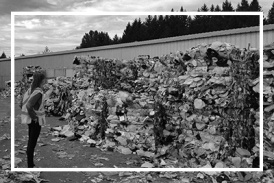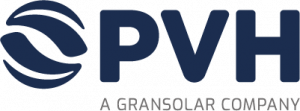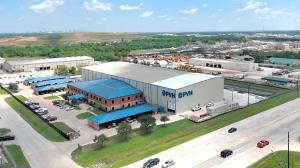PVH USA Doubles Safe Harbor Capacity to10GW of Product, Leveraging Existing Domestic Stock and Manufacturing Capacity
Solar developers are urged to act quickly pending Senate approval of House budget bill and potential Inflation Reduction Act tax credit rollbacks
HOUSTON, TX, UNITED STATES, June 3, 2025 /EINPresswire.com/ -- PV Hardware USA (PVH USA), a global leader in solar tracking and foundation solutions, announced today it has expanded capacity to immediately Safe Harbor 10GW of tracker product, doubling its previously announced capacity of 5GW by leveraging not only its existing U.S. stock but also its domestic manufacturing capabilities. This will enable solar developers to have a critical opportunity to preserve eligibility for current clean energy tax credits amid legislative uncertainty.
The announcement follows passage in the U.S. House of Representatives of a budget‑reconciliation bill that would substantially scale back clean‑energy incentives established under the 2022 Inflation Reduction Act (IRA). While the measure still awaits Senate consideration, developers face a narrowing window to protect project economics.
“Developers need to be prepared to act quickly,” said Rodolfo Bitar, VP of Business Development at PVH USA. “We are ready should this bill become law to provide whatever support our partners need in order to meet all requirements and take advantage of this capacity.”
5 % CAPEX Safe Harbor — act now
Under current Internal Revenue Service guidelines, projects can maintain eligibility for today’s higher tax‑credit values by demonstrating that at least 5% of total capital expenditures (CAPEX) have been incurred before any new legislation takes effect. Procuring key tracker components now can be a strategic step in preserving incentives and minimizing risk. PVH USA’s readiness to Safe Harbor up to 10 GW of product via in‑country stock on hand and flexible manufacturing lines enables developers to meet the 5 % threshold quickly and decisively.
Expanding U.S. manufacturing footprint
PVH continues to expand its U.S. presence and increase self‑manufacturing operations, demonstrating a deep commitment to domestic manufacturing and long‑term support for utility‑scale developers. The company’s planned additional 5 GW manufacturing expansion on top of existing capacity will further strengthen U.S. supply resilience and allow PVH to respond swiftly to evolving market needs and policy changes.
“We are able to act decisively precisely because of our long-term strategy of investing in U.S. capacity and domestic manufacturing,” Bitar said. “Because of this, we are able to provide immediate help to developers in light of potentially impactful legislation.”
IRA impact by the numbers
Enacted in 2022, the Inflation Reduction Act represents the nation’s most significant investment in clean energy, allocating billions in tax incentives for renewable generation, home‑energy efficiency, and electric‑vehicle adoption. The IRA is credited with creating more than 330,000 clean‑energy jobs and unlocking over $70 billion in private investment. The Solar Energy Industries Association projects that U.S. solar employment will double by 2033 and that installed solar capacity will reach 440 GW by 2029.
For more information or to schedule an interview, contact Heidi Bethel at 775‑338‑8420 or heidi@themaverickpr.com.
About PV Hardware: PV Hardware (PVH) is a solar tracker manufacturer and provider of innovative solar tracking solutions for the global solar energy market, including solar trackers, fixed structures and SCADA systems. Each product designed by PVH can be easily installed on any type of terrain, withstands different weather conditions, and is prepared to withstand high winds, supporting any type of module, including thin-film and bifacial. Founded in 2011, PVH has supplied more than 29GW to photovoltaic plants operating in various countries around the world. It is currently the world’s third-largest supplier of solar trackers and structures and has the expertise to properly manage solar tracking installations of any capacity, anywhere. For more information, visit PVHardware.com.
Heidi Bethel
PV Hardware
+1 775-338-8420
email us here
Visit us on social media:
LinkedIn
Legal Disclaimer:
EIN Presswire provides this news content "as is" without warranty of any kind. We do not accept any responsibility or liability for the accuracy, content, images, videos, licenses, completeness, legality, or reliability of the information contained in this article. If you have any complaints or copyright issues related to this article, kindly contact the author above.
The Talk Awards Bestows Three Restaurants with Consecutive Awards for Customer Service
Lawn Edger Market is Expected to Grow at a CAGR of 6.5% by 203 | Fact.MR Report
PathFree Technologies Engages Investment Banking Firm to Accelerate Growth, Reflecting Founder’s Grit-Fueled Vision
Kalendarium
Więcej ważnych informacji
 Jedynka Newserii
Jedynka Newserii

 Jedynka Newserii
Jedynka Newserii

Handel

Ze względu na różnice w cenach surowce wtórne przegrywają z pierwotnymi. To powoduje problemy branży recyklingowej
Rozporządzenie PPWR stawia ambitne cele w zakresie wykorzystania recyklatów w poszczególnych rodzajach opakowań. To będzie oznaczało wzrost popytu na materiały wtórne pochodzące z recyklingu. Obecnie problemy branży recyklingu mogą spowodować, że popyt będzie zaspokajany głównie przez import. Dziś do dobrowolnego wykorzystania recyklatów nie zachęcają przede wszystkim ceny – surowiec pierwotny można kupić taniej niż ten z recyklingu.
Przemysł spożywczy
Rośnie presja konkurencyjna na unijne rolnictwo. Bez rekompensat sytuacja rolników może się pogarszać

Rolnictwo i żywność, w tym rybołówstwo, są sektorami strategicznymi dla UE. System rolno-spożywczy, oparty na jednolitym rynku europejskim, wytwarza ponad 900 mld euro wartości dodanej. Jego konkurencyjność stoi jednak przed wieloma wyzwaniami – to przede wszystkim eksport z Ukrainy i niedługo także z krajów Mercosur, a także presja związana z oczekiwaniami konsumentów i Zielonym Ładem. Bez rekompensat rolnikom może być trudno tym wyzwaniom sprostać.
Transport
Infrastruktury ładowania elektryków przybywa w szybkim tempie. Inwestorzy jednak napotykają szereg barier

Liczba punktów ładowania samochodów elektrycznych wynosi dziś ok. 10 tys., a tempo wzrostu wynosi ok. 50 proc. r/r. Dynamika ta przez wiele miesięcy była wyższa niż wyniki samego rynku samochodów elektrycznych, na które w poprzednim roku wpływało zawieszenie rządowych dopłat do zakupu elektryka. Pierwszy kwartał br. zamknął się 22-proc. wzrostem liczby rejestracji w ujęciu rocznym, ale kwiecień przyniósł już wyraźne odbicie – o 100 proc.
Partner serwisu
Szkolenia

Akademia Newserii
Akademia Newserii to projekt, w ramach którego najlepsi polscy dziennikarze biznesowi, giełdowi oraz lifestylowi, a także szkoleniowcy z wieloletnim doświadczeniem dzielą się swoją wiedzą nt. pracy z mediami.










.gif)

 |
| |
| |
|